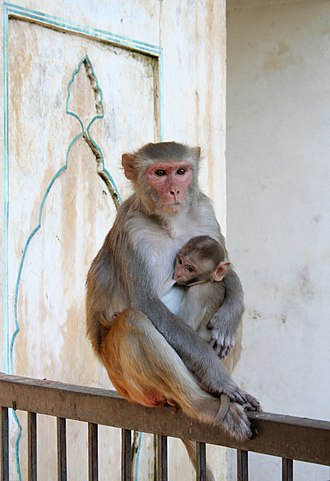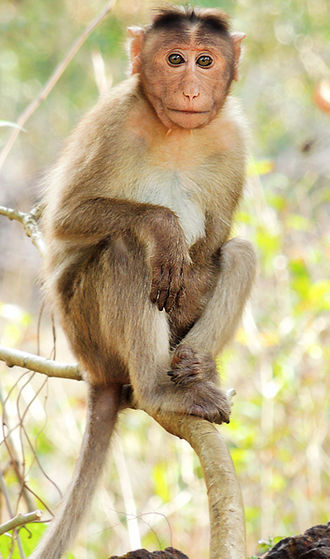Macaques, the old robust primate are the most geographically distributed non-human primate, with about 22 species throughout the world and 12 species throughout Asia mainland. Out of 10 macaque species found in India, the rhesus macaques (Macaca Malatta) were commonly exported for the research and testing because of their anatomical and physiological closeness to human. Besides rhesus, other macaque species like long tailed macaque, crab eating macaque, pig tailed macaque and bonnet macaques also played an important role in the development of various vaccines. For this reason, they have faced the brunt of the illegal wildlife trade.
India has been exporting macaques to North America and Europe in the 20th century, export began to fall from 50,000 to 30,000 a year in 1975 and then from 30,000 to 12,000 a year until the ban in 1978.

Scientific, Cultural and Political Motive behind Macaque’s Export
Macaques were essential for the biomedical research, especially for the poliomyelitis research and endocrinological studies, Species like Rhesus Macaque helped in the development of rabies, small pox and polio vaccines, Rh factor discovery in blood and treatment of reproductive disorder which was one of the many widespread diseases prevailing in India and as India was not in a strong state to develop such crucial vaccine at that period therefore exports were made for the experimental research and mass production of such vaccines. With the macaque’s export, India was trying to tackle not only the prevailing diseases but also the rising macaque-human conflict.
Cultural motive behind exporting macaques is backed by the religious belief, the monkeys (macaques) hold a sacred place in India (among Hindu and Buddhist) due to the Monkey god ‘Hanuman’ therefore even after a rise in the case of human-macaque conflict, the killing of macaques was never considered as an option to control the population therefore the export at that time came out as the best possible solution to reduce cases of conflict. Cultural motives have resulted in the illegal wildlife trade of countless species. This includes snake charming and dancing bears.
Political motive was somewhat based on the mixed factors. Firstly, the macaque’s export began under the period of British rule, when there was no influence or existence of the Indian government and besides that, Britisher and Indian Government (after independence) were earning the foreign exchange. Secondly, after the independence, the newly formed government was not in the situation to keep a check on macaques-human conflict through the immunocontraception and other scientific ways, therefore during the 1950’s there was a periodical ban on the export until the government got into a good position to permanently banned the macaque’s export.
Development of ban on Export
Despite the several benefits obtained from the experiments conducted on macaques, it was the most miserable life for the macaque, and for such smart species there could have been nothing worst then cages. In the 1950’s there was periodical embargoes on export placed by the Indian government after the Hindu’s and Buddhist’s response on the harsh method of trapping, caging and transporting the macaques to western world, besides the reverence for monkeys, the news about the weapon related research by the US Defence Nuclear Agency on macaques also played an important role in the complete ban on the export from India.
Conflict with human and other species
Destruction of natural habitats by the clearance of forest or deforestation for the non-forest purpose resulted in the shortage of food and fragmentation of groups, forcing them to move to rural and urban areas in search of food, creating a conflict situation, which became a matter of concern as these commensal primate causes financial damages (crop destruction, damage to tangible assets) and injuries to both human and macaques, there has been increasing case of conflict where macaques has been kidnapping and killing new born, death of 65 years old by stone pelting by a troop of macaque and many more such incidents.

The translocation of rhesus macaques due to the conflict with humans has led to their widespread establishment in various geographical regions outside their native realm, which caused an extension and creation of new exotic population of the species, creating a pressure on the already existing animal and plant species, due to the absence of any previous exposure to invasive species like macaques, the plants and animals had no evolutionary feature to protect themselves, causing an extinction of native biodiversity, for examples, macaques raids on birds nest for eggs and chicks, they destroys the fruits before maturing and kills the seed, chew the orchids, branches, seedlings, making their environment inhospitable for the small vertebrates. Before 1940 the only macaque species found in Mumbai was Bonnet macaque until the introduction of Rhesus.
Conclusion
Scientific, Political and Cultural motive of exporting the macaques were somehow connected with each other through a thin thread of mitigating the macaque – human conflict situation, but with the time the country became competent enough to find their own ways of tackling the situation without making the life of macaque miserable, in which the religious factor played an important role, putting a ban on the practice of exporting macaques.
Help us Help Them! Think Wildlife Foundation is a non profit organization with various conservation initiatives. Our most prominent campaign is our Caring for Pari intiative. Pari is a rehabilitated elephant at the Wildlife SoS Hospital. 25% of the profits from our store are donated to the elephant hospital for Pari. Other than buying our wonderful merchandise, you could donate directly to our Caring For Pari fundraiser.
References
- Carpenter, C.R., Breeding Colonies of Macaques and Gibbons on Santiago Island, Puerto Rico, The University of Georgia, Athens Ga.
- O’Toole, Thomas, India Banning Monkey Exports to US, The Washington Post, January 14, 1978.
- Biosci, J, Less Than Wild? Commensal Primates and Wildlife Conservation, Commentary, Indian Academy of Sciences, December 2011.
- Florens, Vincent, The Macaque Monkeys of Mauritius: an invasive alien species, and a major export for research, down To Earth, February 23, 2022.
- Sinha, Anindya, Thinking about the Urban Macaques of India, Sustainability Zero, August 26, 2021.
- Sharonstjoan, 1978 – Rhesus Monkeys – Stopping their Export for Research, April 10, 2015.
- Mukherjee, Ritoban, Indias Monkeys Keep Killing People, So Scientists are Trying Radical New Sterlization Strategies, Gizmodo, May 25, 2019.
